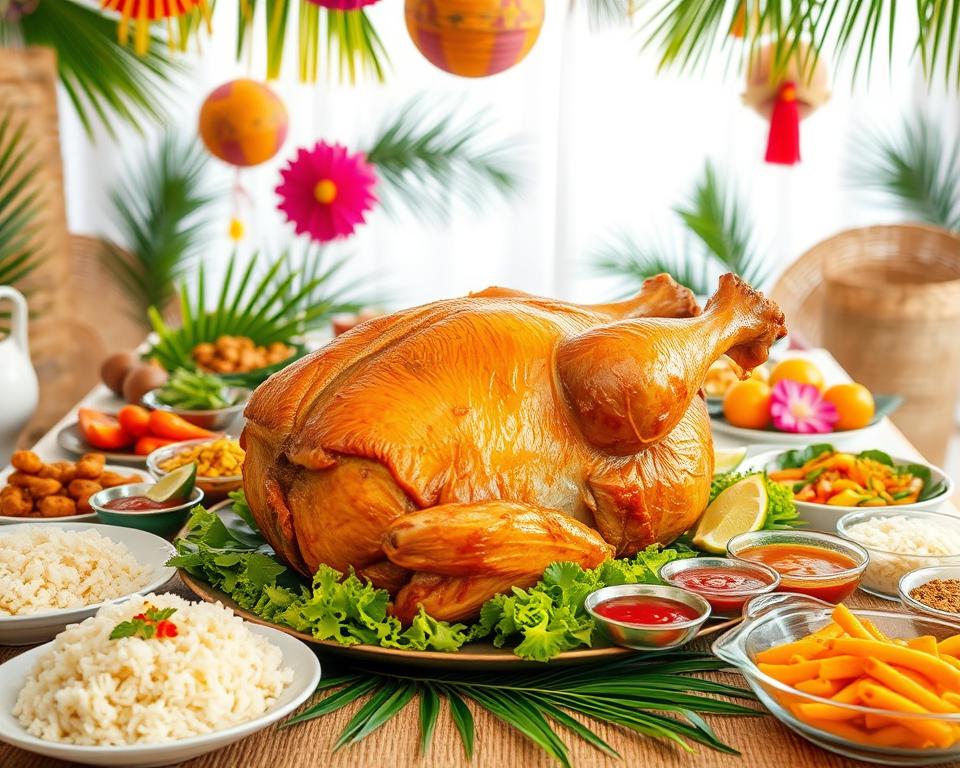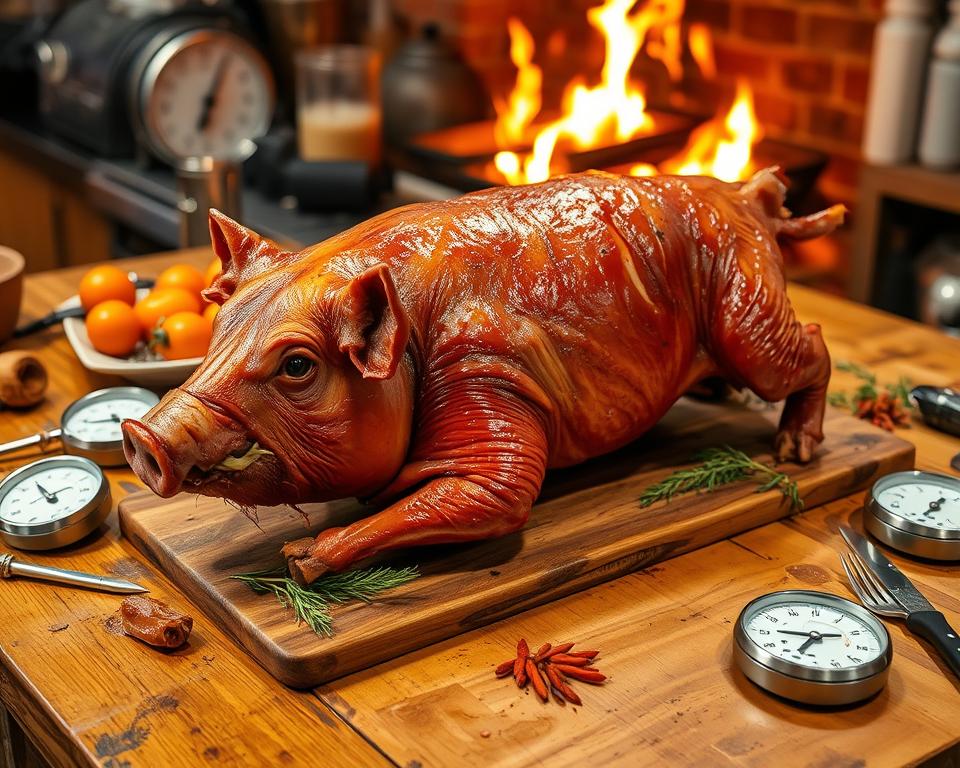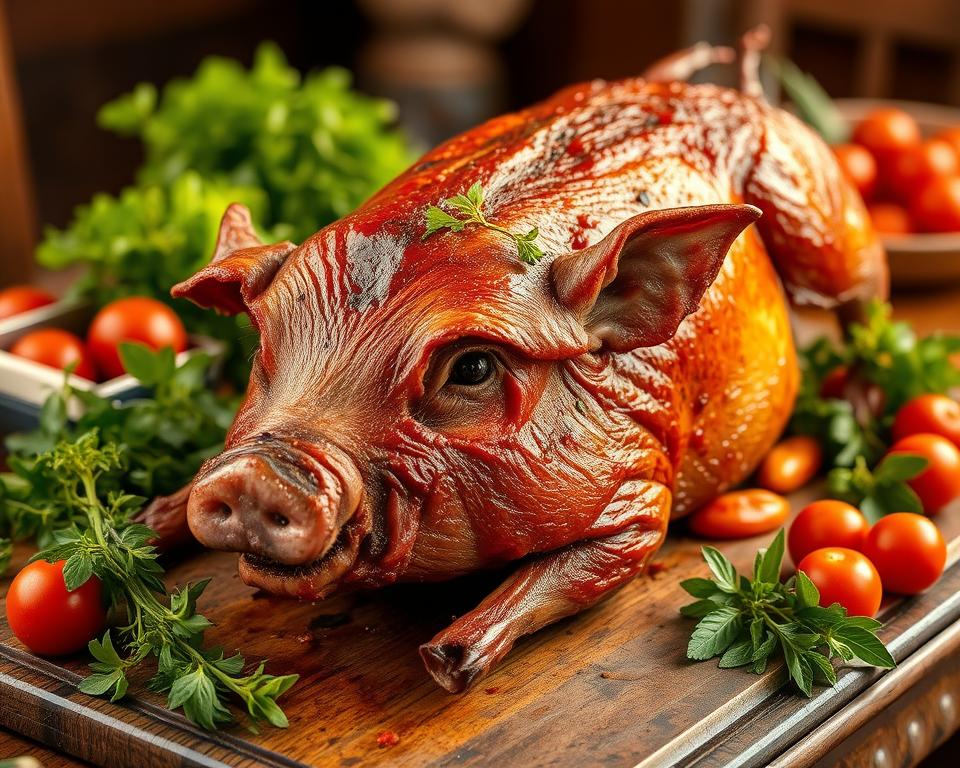The smell of roasted, golden-brown skin fills the air. The meat is tender and juicy, falling off the bone easily. This is the magic of suckling pig, a dish loved by food lovers worldwide. It comes from many cultures and is known for its special flavors and textures.
Suckling pig, or “cochinillo,” “lechon,” or “milk-fed pork,” is a young piglet’s meat. It’s roasted or fried to perfection. This makes the skin crispy and the inside soft, a true treat for the senses. It’s enjoyed in Spain’s tapas bars, the Philippines’ streets, and fancy restaurants everywhere, winning hearts and taste buds.
Read interesting things at : legend-of-raphael
Key Takeaways
- Suckling pig is a prized culinary delicacy known for its tender, juicy meat and crispy, golden-brown skin.
- This gourmet pork dish has its origins in diverse cultural traditions around the world, including Spain, the Philippines, and beyond.
- Suckling pig is celebrated for its unique flavors, unparalleled textures, and captivating aroma when roasted or fried to perfection.
- Whether enjoyed in traditional settings or fine-dining establishments, suckling pig has become a beloved dish among food enthusiasts globally.
- The preparation and presentation of suckling pig involve intricate techniques and regional variations that contribute to its culinary allure.
What is Suckling Pig?
Suckling pig is a dish loved by many. It’s a young piglet, usually still nursing, that’s roasted whole. This dish comes from Spain, the Philippines, and Latin America. It’s known for its rich flavor and tender meat.
Definition and Origins
The term “suckling pig” or “cochinillo” means a young, milk-fed pig. These pigs are under 4 weeks old. They’re roasted until their skin is golden and crispy, making a perfect contrast to the soft meat inside.
Nutritional Value and Benefits
- Suckling pigs are a lean source of protein, providing essential amino acids and minerals.
- They are rich in vitamins B6 and B12, as well as important minerals like iron, zinc, and phosphorus.
- Compared to older pork, suckling pig is often considered a healthier and more nutritious gourmet pork dish.
“Suckling pig is a culinary treasure that has captivated the hearts and palates of food enthusiasts around the world.”
Varieties of Suckling Pig
While cochinillo, the famous suckling pig of Spain, and lechon, the iconic dish of the Philippines, are well-known, there’s more to suckling pig. Each place and culture has its own twist on this tasty dish. This shows off local ingredients, traditions, and tastes.
The filipino lechon is tender and delicate, while the spanish delicacy is savory and crispy. Suckling pig’s versatility shows it’s loved everywhere. It can be roasted, slow-cooked, or seasoned with spices, offering a unique taste experience.
Discover the different suckling pig varieties and their special qualities. Learn about the flavors and traditions of these regional dishes. Start a food journey that celebrates the diversity and creativity of this beloved dish.
“The true essence of a region’s culinary identity is often found in its most revered and cherished dishes, and the suckling pig is undoubtedly one of those iconic specialties that transcends borders and captivates the hearts and palates of food enthusiasts worldwide.”
Traditional Cooking Methods
The preparation of the roasted piglet is a true art. The most popular method is roasting. This skill is mastered by lechoneras or cochineras.
These places use old techniques and wood-fired ovens. They make the skin crispy and the meat juicy and flavorful. The slow-roasting, basting, and seasoning make the dish look great and taste amazing.
Regional Variations
Worldwide, suckling pig is prepared in many ways. Each place adds its own twist, from Caribbean spices to Latin American smokiness. This makes the dish a true reflection of local tastes.
- In the Philippines, the lechon is a big deal. It’s known for its crispy skin and tender meat.
- In Spain, the cochinillo asado is a favorite. It’s served with sides that enhance its rich flavors.
- In China, the siu yuk is a prized dish. The pork is slow-roasted and served with various sauces.
The roasted piglet is a culinary gem. It shows the creativity and skill of cooking traditions from everywhere.
Suckling Pig Preparation and Presentation
Making a delicious suckling pig dish is an art. It needs careful attention to seasoning, marinating, and how it looks. Chefs and home cooks use many techniques to make the pork belly crispy and flavorful.
Seasoning and Marinating
The secret to a tender suckling pig is in the seasoning and marinating. Chefs rub the meat with herbs and spices like garlic, rosemary, thyme, and sea salt. This mix boosts the pork’s flavor and makes it tender.
For more flavor, cooks marinate the pig in citrus juices, vinegar, or wine. This softens the meat and adds a tangy taste that goes well with the pork’s richness.
Garnishing and Plating
The way a suckling pig is presented is just as important as how it’s made. Chefs add vibrant ingredients like apple slices, herbs, and edible flowers. These add to the dish’s look and offer a nice contrast in flavors and textures.
When plating, chefs aim to show off the pig’s golden skin and juicy meat. Some present the whole pig, while others carve it and arrange it with side dishes and sauces.
| Seasoning Blend | Marinating Ingredients | Garnishing Options |
|---|---|---|
| Garlic, Rosemary, Thyme, Sea Salt | Citrus Juices, Vinegar, Wine | Apple Slices, Herbs, Edible Flowers |
By focusing on seasoning, marinating, and presentation, chefs can make a memorable dining experience. They highlight the suckling pig’s natural flavors and textures.
Serving and Pairing Suckling Pig
Serving the perfect gourmet pork dish like succulent suckling pig needs thought. It’s about enhancing flavors and making the meal enjoyable. The meat is tender, juicy, and the skin is crispy. Pairing it with the right side dishes, sauces, and drinks can make the pork’s natural flavors shine.
Experts say to pair the gourmet pork dish with drinks like full-bodied red wines or cool cocktails. This makes the meal unforgettable. The right drink can balance the pork’s rich flavors, making the meal even better.
Recommended Pairings
- Dry, medium-bodied red wines, such as Tempranillo or Malbec, complement the richness of the gourmet pork dish.
- Crisp, acidic white wines like Sauvignon Blanc or Albariño can provide a refreshing contrast to the pairing suckling pig.
- Craft cocktails featuring citrus or herbal notes can also be a delightful accompaniment to the gourmet pork dish.
When serving the pairing suckling pig, think about how it looks and what sides to serve. Roasted veggies, creamy mashed potatoes, or a tangy slaw are great with it.
By choosing the right way to serve and pair the pairing suckling pig, chefs and home cooks can make a meal that’s both memorable and delicious. It’s all about celebrating the rich flavors and textures of this amazing gourmet pork dish.
Cultural Significance and Traditions
Suckling pig is deeply meaningful in many cultures, tied to traditions and celebrations. In Spain, the cochinillo is a beloved dish, part of the country’s food heritage for ages. In the Philippines, the lechon is key at many festivals and special events, showing its big role in Filipino life and identity.
Festivals and Celebrations
The making, showing, and eating of suckling pig are big parts of cultural events. In Spain, the cochinillo is a key dish at festivals like the Fiesta de San Juan. There, families and communities come together to enjoy this spanish delicacy.
In the Philippines, the filipino lechon is a star at Christmas, New Year’s, and weddings. It shows the cultural significance of this dish in the Philippines’ food traditions.
“The lechon is the centerpiece of any Filipino celebration, a symbol of prosperity and abundance.”
These traditions around suckling pig show how food, identity, and celebrating life’s big moments are connected. The care and love put into making and sharing these dishes show the lasting cultural significance of this food.

Health Benefits and Concerns
Suckling pig is a treat for the senses, with its tender meat and crispy skin. But, it’s important to think about its nutritional value and health effects. It’s a lean source of protein, offering important nutrients and minerals. Yet, its high fat content and cooking methods, like roasting, might affect heart health.
To enjoy suckling pig without harming your health, it’s key to know its benefits and drawbacks. Understanding its nutritional value and health concerns helps make smart diet choices.
Nutritional Profile of Suckling Pig
Suckling pigs are packed with good stuff:
- High-quality protein
- Essential vitamins and minerals, like iron, zinc, and B-complex vitamins
- Moderate amounts of monounsaturated and polyunsaturated fats
Health Considerations
Despite its nutritional benefits, suckling pig has health concerns:
- Its high fat content, especially saturated fats, can raise cholesterol and heart disease risk
- It might have high sodium levels, depending on how it’s seasoned and cooked
- Eating too much can lead to weight gain and related health problems
Enjoying suckling pig in moderation as part of a balanced diet is key. This way, you can enjoy its culinary delights while keeping your health and wellness in check.
“The key is finding the right balance between indulgence and moderation when it comes to incorporating suckling pig into one’s diet.”
Sourcing and Purchasing Quality Suckling Pig
Getting the right purchasing quality suckling pig is key for a great dish. It’s important to buy from trusted suppliers and farms. They should follow ethical and sustainable practices.
When looking for purchasing quality suckling pig, consider a few things. The pig’s age, breed, and diet affect the meat’s quality and taste. Look for a suckling pig that’s 2-6 weeks old. This age ensures the meat is tender and flavorful.
- Choose farms that raise pigs humanely and feed them well, without hormones or additives.
- Opt for breeds like Berkshire or Ibérico pigs for their great taste and texture.
- Find a local butcher or specialty market you can trust for advice on purchasing quality suckling pig.
By carefully choosing and purchase quality suckling pig, your dish will be amazing. It will be full of flavor and tender.
“The secret to a truly remarkable suckling pig lies in the quality of the meat itself.”
Creating a delicious suckling pig dish starts with the right meat. Investing in purchasing quality suckling pig sets the stage for a memorable meal.
Cooking Tips and Techniques
Learning to cook a delicious suckling pig is all about mastering temperature, timing, and special techniques. The goal is to get the skin crispy and the meat tender and juicy. This is what every chef and home cook aims for.
Temperature and Timing
When roasting a suckling pig, keeping the right temperature is key. The meat should reach 145°F (63°C) to be cooked perfectly without drying out. Basting the pig with its juices or a tasty marinade keeps it moist and browns the skin evenly.
It’s important to watch the cooking time closely. A 10-12 lb (4-5 kg) pig usually takes 2-3 hours to cook. This helps avoid overcooking the meat.
Carving and Serving
How you present the suckling pig is just as important as how you cook it. Start by carving the skin into small pieces. Then, slice the meat thinly and evenly, keeping its natural shape.
Arrange the carved pieces on a platter in a beautiful way. Add fresh herbs, citrus wedges, or a bit of the roasting juices for a stunning look.
By using these expert tips, both home cooks and chefs can make their suckling pig dishes unforgettable. It’s all about the details that make a meal special.

| Cooking Technique | Temperature | Timing |
|---|---|---|
| Roasting | 145°F (63°C) | 2-3 hours (10-12 lb/4-5 kg suckling pig) |
| Basting | N/A | Regular intervals |
| Carving | N/A | Slice skin and meat into even portions |
Suckling Pig in Global Cuisine
Suckling pig is loved in many parts of the world, not just where it’s from. From Spain’s cochinillo asado to the Philippines’ lechon kawali, and Mexico’s cochinita pibil, each place has its own twist. These dishes show how different cultures enjoy and prepare this special pork.
International Variations
Everywhere, making suckling pig is an art that shows off local tastes and cooking styles. Here are a few examples:
- In Spain, the cochinillo asado is a classic roasted suckling pig dish, often served with crispy skin and accompanied by potatoes and vegetables.
- The Philippines is renowned for its lechon kawali, a deep-fried version of suckling pig that is known for its juicy meat and crackly skin.
- Mexico’s cochinita pibil features slow-roasted suckling pig marinated in a blend of citrus, achiote, and spices, often served in tacos or on a plate with accompaniments like pickled onions and habanero salsa.
- In China, the siu yuk is a Cantonese-style roasted suckling pig, characterized by its crispy skin and tender, flavorful meat.
- In Cuba, the lechón asado is a popular dish that showcases the succulent roasted pork, often served with rice, beans, and plantains.
These variations show how suckling pig brings people together, celebrating the diversity of food and culture worldwide.
“Suckling pig has transcended its regional boundaries, becoming a global culinary phenomenon that allows diverse cultures to showcase their unique culinary identities.”
Popular Suckling Pig Dishes
Suckling pig has inspired many dishes, each showcasing its flavor and texture. From classic roasted whole suckling pig to innovative dishes, it has won the hearts of many. Its versatility has made it a favorite in the culinary world.
The traditional roasted whole suckling pig is a standout. It offers tender meat and crispy skin, making it a stunning centerpiece for any event.
The crispy pork belly is another favorite. It’s made by slow-roasting the pig’s belly until the skin is crunchy. It’s often served with pickled vegetables or tangy sauces to complement its rich flavor.
Braised suckling pig is great for those who love hearty dishes. It’s cooked slowly in a flavorful broth, making the meat tender and infused with spices and herbs.
Suckling pig is also used in fusion cuisine. Chefs have created dishes like suckling pig tacos and Asian-style rice bowls. These dishes show how versatile and special this pork is.
| Dish | Description |
|---|---|
| Roasted Whole Suckling Pig | The iconic presentation of the entire suckling pig, roasted until the skin is crispy and the meat is tender and juicy. |
| Crispy Pork Belly | Slow-roasted suckling pig belly with a satisfyingly crunchy skin and rich, succulent meat. |
| Braised Suckling Pig | Tender, fall-off-the-bone pork cooked in a flavorful broth with aromatic spices and herbs. |
| Fusion Cuisine Dishes | Innovative dishes that incorporate suckling pig, such as suckling pig-inspired tacos and Asian-influenced rice bowls. |
These popular suckling pig dishes offer unique and delightful ways to enjoy this culinary treasure. They showcase the versatility and exceptional flavor of this gourmet pork item.
Conclusion
The journey into the world of suckling pig has shown us a mix of tradition, culture, and taste. Its tender meat and crispy skin have won over food lovers everywhere. This dish is loved in many ways, from classic roasts to new twists in cooking.
As we end this journey, it’s clear that suckling pig’s charm will keep inspiring food lovers. Its health benefits, many cooking styles, and cultural importance make it a favorite for many. The world of suckling pig celebrates great ingredients and the skill that makes them special.
The beauty of suckling pig is more than just its taste. It’s about the traditions, creativity, and skill that have made it a classic. Every bite reminds us of the endless possibilities in gourmet pork dishes. It invites us to keep exploring and enjoying the timeless joy of suckling pig.
